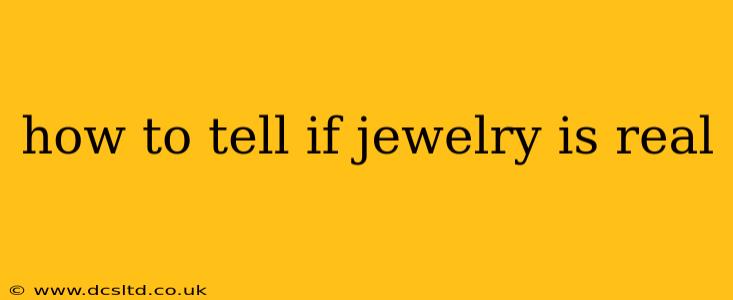Determining the authenticity of jewelry can be tricky, especially with the abundance of imitation pieces available. This comprehensive guide will equip you with the knowledge and techniques to distinguish genuine jewelry from its counterfeits. Whether you're a seasoned collector or a first-time buyer, understanding these methods will empower you to make informed decisions and protect your investment.
What are the hallmarks of genuine jewelry?
Before diving into specific tests, understanding the characteristics of genuine jewelry is crucial. Real gold, platinum, and silver typically possess specific hallmarks, stamps, or markings indicating their purity and origin. These are usually subtle, requiring a close inspection with magnification if needed. Look for manufacturer's marks, country of origin stamps, and purity stamps (e.g., 14K, 18K for gold; .925 for sterling silver). The absence of these hallmarks doesn't automatically mean the jewelry is fake, but their presence significantly strengthens the case for authenticity.
How can I test gold jewelry at home?
Several at-home tests can help determine if your gold jewelry is genuine. However, it's essential to remember these are preliminary tests and don't provide definitive proof. For a conclusive assessment, professional appraisal is recommended.
The Acid Test:
This is a classic method, but it's destructive and should only be used on inconspicuous areas or with a jeweler's acid testing kit. A small amount of acid is applied to the jewelry; a reaction indicates the metal's composition. This method is not recommended for beginners and can damage jewelry if incorrectly applied.
The Magnet Test:
Gold is not magnetic. If your jewelry is strongly attracted to a magnet, it's likely not genuine gold. However, some gold alloys might show slight magnetic attraction. This is a quick, non-destructive preliminary test but not definitive.
The Weight Test:
Genuine gold is dense and heavy. Compare the weight of your piece to similarly sized pieces of known genuine gold. If it feels noticeably lighter, it might be a counterfeit. This test requires experience and a good comparative reference piece.
How do I check if my silver jewelry is real?
Testing silver jewelry for authenticity involves similar methods as gold, but with some variations.
The Hallmarking Method:
Sterling silver (92.5% silver) typically carries the ".925" hallmark. Inspect the piece closely for this marking. Other hallmarks might indicate the manufacturer or country of origin.
The Magnet Test:
Like gold, pure silver is not magnetic. If your silver jewelry is strongly attracted to a magnet, it's likely not genuine sterling silver.
The Acid Test:
Similar to the gold acid test, the acid test for silver can be used, but again, it's destructive and requires expertise to avoid damaging the piece. It is not advised to try this at home without professional guidance.
How can I tell if my diamond is real?
Diamonds possess unique optical and physical properties that distinguish them from imitations like cubic zirconia or moissanite.
The Fog Test:
Exhale on the stone. A genuine diamond will quickly dissipate the fog, while imitations may retain it for a longer period. This is a simple and quick test, but not foolproof.
The Light Test:
Genuine diamonds exhibit brilliant sparkle and scintillation, dispersing light into a rainbow effect. Imitations may appear duller or exhibit less fiery sparkle.
The Heat Test:
Genuine diamonds can withstand intense heat without damage. Imitations may crack or change color under extreme heat. This is a very risky test that should not be performed unless under the guidance of a trained professional.
What are some other ways to tell if my jewelry is real?
Beyond the previously mentioned tests, consider these additional factors:
Professional Appraisal:
For valuable or precious jewelry, a professional appraisal from a certified gemologist or jeweler is the most reliable way to determine authenticity. They possess the expertise and equipment (like spectrometers) to conduct thorough analyses.
Reputation of the Seller:
Purchasing from reputable jewelers and established retailers significantly reduces the risk of buying counterfeits. Check online reviews and the seller's background.
Price Point:
Be wary of exceptionally low prices for high-quality precious metals and gemstones. An unusually low price might indicate that the piece is counterfeit or of significantly lower quality than advertised.
How can I test jewelry for precious metals without damaging it?
Non-destructive testing methods are preferred to protect your jewelry. The magnet test and careful observation of hallmarks are good starting points. A reputable jeweler offers non-destructive analysis methods, such as X-ray fluorescence (XRF) spectroscopy, to determine the precise composition of the metal without damaging the piece.
Are there any easy ways to tell if my gemstones are real?
While there are simple tests like the fog test for diamonds, many gemstones require expert examination. A gemologist uses tools like a refractometer, spectroscope, and magnification to identify gems, assessing their refractive index, color spectrum, and inclusions (internal characteristics).
Remember, purchasing from trusted sources and seeking professional appraisals are crucial steps in ensuring the authenticity of your jewelry. While home testing provides a preliminary assessment, it should never replace expert evaluation for high-value pieces.
